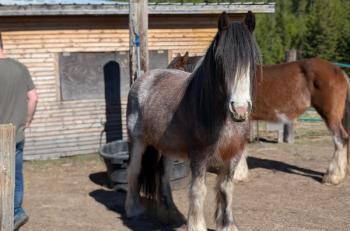
Equine fluid therapy--not just lactated ringer's solution (Proceedings)
Administration of fluids to horses with various disease processes is one of the foundations of treatment for equine practitioners.
Administration of fluids to horses with various disease processes is one of the foundations of treatment for equine practitioners. While sterile isotonic fluids such as Lactated Ringers Solution (LRS) are commonly used to rehydrated horses, a variety of other fluid formulations and supplements are available for horses.
Total body water
The clinician should have a general knowledge of the distribution of water within the body when contemplating fluid needs. The estimated total body water (TBW) in the adult horse is 60-70% of the body weight corresponding to approximately 300 liters in the 500 kg horse. The TBW can be further divided into intracellular fluid (ICF; 40% of body weight) and extracellular fluid (ECF; 30% of body weight). The ECF compartment is further divided into transcellular fluid (CSF, pleural, peritoneal, synovial, GI), interstitial fluid and plasma. Based on the 500 kg horse, this corresponds to approximately 200 L of intracellular fluid and 100 L of extracellular fluid (30-35 L of plasma; 50-75 L of interstitial fluid/lymph; 30-50 L of transcellular fluid).
Determination of fluid requirements
While assessment of TBW through sodium dilution or multi-frequency bioelectrical impedance analysis in horses may provide a more accurate evaluation of total body water and ECF and ICF volume, these methods are currently impractical for clinical use. Thus, veterinarians commonly use various physical exam findings to estimate the hydration status of the horse.
This may include observation of mentation and temperature of extremities, pulse quality, capillary refill time, mucous membrane color, heart rate and skin tent. While these observations may indeed loosely correlate with hydration status, one must remember that many of these findings are subjective and can be altered by various causes.
More objective parameters that can be used to evaluate the hydration status of the horse include measurement of the packed cell volume and total protein (PCV/TP), urine specific gravity, serum lactate trends, central venous pressure, blood pressure and trends in body weight, although many of these may be altered by various disease processes as well. The clinician is encouraged to monitor trends in these objective measurements to better estimate the hydration status of the patient as well as evaluate the response to fluid therapy.
Crystalloids
Crystalloids are fluids containing small molecular weight molecules, such as electrolytes or glucose, which readily cross the capillary membranes. Replacement fluids are isotonic compared to the ECF and mimic the composition of the plasma and ECF and include preparations such as LRS, Normosol-R, and Plasmalyte-R; maintenance fluids are hypotonic compared to the ECF and contain less sodium and potassium then replacement fluids. They include preparations such as Normosol-M and Plasmalyte 56.
Fluid rates
Continuous administration of IV fluids is commonly implemented in the hospital situation but may be more difficult in the field setting. The amount of fluid necessary to reverse hypovolemia is variable, depending on the severity. However, in the hypovolemic adult horse, 20-80 mL/kg (10-40L in a 500 kg horse) as an IV bolus should be considered initially. Subsequently, re-evaluation of patient hydration should be performed, based on the subjective and objective parameters discussed above, and the fluid plan should be adjusted as necessary.
Commonly, replacement fluids, such as LRS, are used for resuscitation as an IV bolus which rapidly replaces fluid deficits in the hypovolemic horse; however, after replacement of acute deficits, the remainder of the bolus can cause a transient state of hypervolemia to which the body responds by renal elimination. In addition, only a portion (30-50%) of crystalloids that are administered as a bolus remain within the vascular space 30 minutes after administration, with a large percentage quickly redistributed to the ECF. Thus, bolus administration of crystalloids is important in the rapid restoration of fluid deficits but may not be ideal therapy for sustained fluid losses.
Due to the time involved in administering large volumes of IV fluids (30-40L) some clinicians may choose to administer solutions, such as hypertonic saline (3-4 mL/kg) or hetastarch (5-10 mL/kg), which rapidly expand the intravascular compartment. However, all of the above fluid replacement techniques require administration of a continuous infusion of IV fluids at a minimum goal of meeting the standard maintenance dose of 60-75 mL/kg/day (30 L/day for 500 kg horse), adding more to compensate for ongoing losses (i.e. diarrhea) if necessary. In the field setting, the clinician may be left with only bolus therapy as an option. However, periods of hypovolemia may occur if enough time elapses between bolus doses. Reliance on lay horse-owners to administer continuous fluids is controversial and left to the attending veterinarian.
Oral Fluids, administered via NG tube, are a cost effective method of supplementing fluid intake in certain situations where the intestinal tract is able to absorb fluids. In horses that are moderately to severely hypovolemic, IV administration of fluids should be considered rather than oral fluids. As well, horses with severe enterocolitis may not have the functional capacity to completely absorb orally administered fluids. The administration of pure water has been documented to be of minimal benefit in restoring plasma volume in horses exercised in hot and humid conditions.1,2 Therefore, if at all possible, oral fluids with electrolytes should be administered.
One formulation for an isotonic solution consists of 4.9 grams/liter of table salt (NaCl) and 4.9 grams/liter of lite salt (KCl) which yields a concentration of 123 mEq/L of sodium, 157 mEq/L of chloride and 34 mEq/L of potassium.1,2 This can be estimated by 15 mLs each of table salt and lite salt in 4 liters of water. In a 500 kg horse, the veterinarian can administer 5-6 liters of oral fluids at a time, as often as every 30 minutes. Evaluation of gastric reflux should be performed prior to subsequent administration of additional oral fluids. Some horses may demonstrate signs of colic with oral fluid administration; if this occurs, the volume should be decreased or an alternate route of fluid supplementation should be selected.
Electrolyte Supplementation is readily available for most electrolytes and is often times necessary to correct specific deficiencies. Because the horse's diet typically contains large amounts of K+ and Ca++, horses that have decreased appetite or are anorexic will continue to excrete K+ (via kidneys) and have less Ca++ absorption from the gut. In addition, most crystalloid fluids have little K+ and Ca++, thus horses on IV fluids can develop hypokalemia and hypocalcemia, unless further supplementation is implemented. Rechecking of electrolytes is important when supplementation is used because gauging the amount necessary to compensate for deficits can be difficult.
· Sodium – Serum sodium in a healthy adult horse is in the range of 135-140 mEq/L. Most commercially available isotonic fluid solutions contain sodium to replace or maintain this concentration. However, if a patient has a serum sodium concentration of < 125 mEq/L, additional sodium supplementation should be considered. If sodium is < 110 mEq/L, neurologic signs may develop and sodium correction needs to be accomplished carefully. A general formula that can be estimate the sodium deficit is as follows: Na+ required = (Desired Na+ – Patient Na+) x 0.6 x BWT (kg). For example, if the patient weighs 50kg and the serum sodium is 110 and you want to raise it to 125 you would need to add approximately 450 mEq of sodium to the fluid plan (125-110 x 0.6 x 50 kg). Sodium can be supplemented IV via solutions such as 7.2% hypertonic saline (1232 mEq/L) or orally via table salt (1 gram = 17 mEq Na+ & Cl-)
· Potassium – Potassium is primarily an intracellular cation with serum concentrations in health ranging from 3.5-4.5 mEq/L. The most common formulation available for IV supplementation is potassium chloride (KCl) containing 2 mEq/mL of K+. Potassium can be safely administered at a rate of 0.5 mEq/kg/hr; commonly, 20-40 mEq of KCL is added per liter of fluids. Oral supplementation of lite salt provides 13 mEq of K+ per gram of salt.
· Calcium – Total calcium is divided into ionized (55%; free-form), protein bound (45%) and complexed with anions (5%) with the ionized form being the best gauge for the need for supplementation. Ionized calcium concentrations less than 3.6 mg/dL (0.9 mmol/L) may require additional calcium. Different methods of calcium supplementation exist but for those who like exact calculations, the following formula can be used as a guide to estimate calcium deficits:
o Ca++ deficit=(6.5-Ca++)(10)(0.3)(BWT[kg])/Ca++ratio where the Ca++ ratio=iCa++/total Calcium
o Example: 450 kg horse w/Ca++ of 4.5 mg/dL and total Calcium of 10 mg/dL
§ (6.5-4.5)(10)(0.3)(450) = 6000 mg Calcium
4.5/10
23% Calcium Gluconate contains 21.4 mg/mL of elemental calcium. Other methods of calcium supplementation include adding 250-500 mLs of 23% calcium gluconate to 10 liters of fluids and then rechecking the calcium status. Avoid combining calcium with bicarbonate as they may react.
· Sodium Bicarbonate – In general, one should consider using sodium bicarbonate in cases of metabolic acidosis in which the HCO3 is < 15 mEq/L and the pH is < 7.25. Often, rehydration and electrolyte correction will allow correction of acid-base status, negating bicarbonate supplementation. The formula to calculate bicarbonate supplementation is: HCO3 deficit = BWT(kg) x base deficit x 0.4. Sodium bicarbonate can be administered at various concentrations including 1.3% (0.156 mEq/mL), 5% (0.6 mEq/mL) and 8.4% (1 mEq/mL). Oral supplementation is also an inexpensive method of replacement with 1 gram of salt (baking soda) containing 12 mEq of NaHCO3.
· Magnesium & Phosphorus – Mg and Phosphorus are often overlooked electrolytes that may be deficient in various equine diseases. Magnesium sulfate can be administered at a rate of 2-8 mg/kg, IV whereas Phosphorus can be administered at an IV rate of 0.01-0.03 mmol/kg/hr.
Colloids
Colloids are fluids that contain large sugar or protein molecules that are unable to cross the capillary membranes and therefore persist within the vascular space for longer periods when compared to crystalloids. These larger molecules exert osmotic pressure and consequently draw fluid into the vascular space. Because of this trait, colloids are excellent choices for resuscitation (require shorter infusion times and less volume) or treatment of hypoproteinemic patients. The most readily available colloids include 6% hetastarch, human albumin, and equine plasma.
Hetastarch is the most commonly utilized synthetic colloid used in horses and contains modified branch-chain glucose polymers of amylopectin; these molecules are slowly metabolized by α-amylase prior to renal excretion and uptake by the reticulendothelial system. The COP of 6% hetastarch is 30-33 mmHg and is typically administered at a dose of 10 mL/kg. In one experimental study, hetastarch (10 mL/kg) increased the COP from 24 to 27 mmHg in healthy ponies for at least 120 hours whereas the duration of action was only 24-36 hours in hypoproteinemic horses and foals.
Hetastarch (~$50/500 mLs) may be more cost effective when compared to equine plasma (~$125/1000 mLs) and is easily stored and readily available. However, refractometry (total protein) does not account for the oncotic contribution of synthetic colloids and therefore, COP must be monitored (normal COP adult horse: 20-27 mmHg; foal: 17-21 mmHg). A side effect of hetastarch is decreased circulating von Willebrand's factor (vWF) and factor VIII activity at higher (i.e. 20 mL/kg) doses potentially resulting in coagulopathies.
Albumin (5 or 25%) has numerous functions including maintenance of intravascular COP, serving as a buffer for anions and cations and as a transport protein for medications and hormones, among other duties. Albumin accounts for approximately 80% of the plasma COP and also has a negative charge that attracts cations such as sodium to which water follows (Gibbs-Donnan effect). 30-40% of albumin is located in the intravascular space whereas the remainder is within the extravascular compartment.
There is a slow flux of albumin between these two pools. In situations of severe hypoproteinemia, administration of human albumin should be considered. On a small equine report, administration of 25% human albumin raised the COP in hypoproteinemic horses from 9.7 to 16.6 mmHg as compared to an increase in COP of 11.4 to 13.3 mmHg when Hetastarch was administered. No large studies exploring the use of human albumin in horses has been published but anecdotal evidence supports its use in certain circumstances.
Equine Plasma
Frozen equine plasma is readily available through a number of commercial sources and has the benefit of not only providing albumin and contributing to increased COP, but also has other valuable serum proteins such as immunoglobulins, fibronectin, antithrombin and clotting factors. The COP of plasma is approximately 20-25 mmHg. Plasma should be administered through a blood administration/filter set and patients should be monitored for transfusion reactions that would include pyrexia, tachycardia, tachypnea, muscle tremors, urticarial or signs of colic.
References
Marlin DJ et al. Rehydration following exercise: effects of administration of water versus an isotonice oral rehydration solution (ORS). Vet J 1998;156:41-49.
Sosa Leon LA et al. The effects of tonicity, glucose concentration and temperature of an oral rehydration solution on its absorption and elimination. Equine Vet J 1995;Suppl(20):140-146.
Jones PA et al. Effect of hydroyethyl starch infusion on colloid oncotic pressure in hypoproteinemic horses. JAVMA 2001:218:1130-5.
Jones PA et al. Oncotoic, hemodilutional, and hemostatic effects of isotonic saline and hydroxyethyl starch solution in clinically normal ponies. Am J Vet Res 1997;58:541-8.
Dewitt SF. Proceedings 22nd Annual ACVIM Convention, 2004.
Newsletter
From exam room tips to practice management insights, get trusted veterinary news delivered straight to your inbox—subscribe to dvm360.






